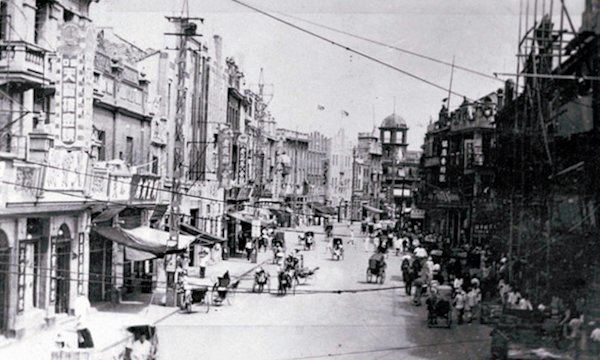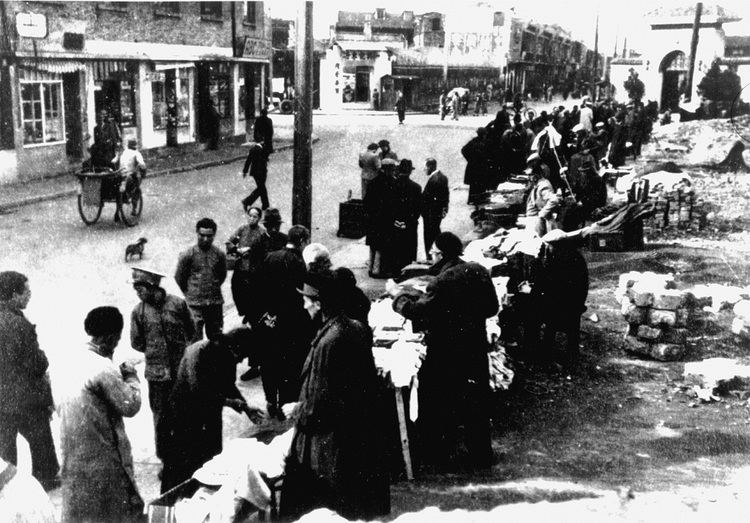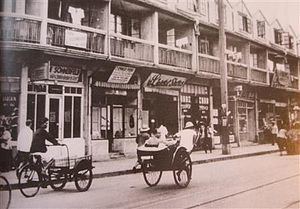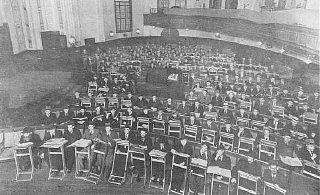Chinese 上海隔都 Wade–Giles Shang-hai ko-tou Simplified Chinese 无国籍难民限定地区 | Hanyu Pinyin Traditional Chinese 無國籍難民限定地區 | |
 | ||
Hanyu Pinyin | ||
The Shanghai Ghetto, formally known as the Restricted Sector for Stateless Refugees, was an area of approximately one square mile in the Hongkew district of Japanese-occupied Shanghai (the southern Hongkou and southwestern Yangpu districts of modern Shanghai). The area included the community around the Ohel Moshe Synagogue but about 23,000 of the city's Jewish refugees were restricted or relocated to the area from 1941 to 1945 by the Proclamation Concerning Restriction of Residence and Business of Stateless Refugees. It was one of the poorest and most crowded areas of the city. Local Jewish families and American Jewish charities aided them with shelter, food, and clothing. The Japanese authorities increasingly stepped up restrictions, but the ghetto was not walled, and the local Chinese residents, whose living conditions were often as bad, did not leave.
Contents
- Shanghai ghetto official film trailer
- Jews in 1930s Germany
- Shanghai after 1937
- Chiune Sugihara Tadeusz Romer and Ho Feng Shan
- Arrival of Ashkenazi Jews
- Life in the Restricted Sector for Stateless Refugees
- After Pearl Harbor 19411943
- Further restrictions 19431945
- After liberation
- Partial list of notable refugees in the Restricted Sector for Stateless Refugees
- Films
- References

Shanghai ghetto official film trailer
Jews in 1930s Germany

At the end of the 1920s, most German Jews were loyal to Germany, assimilated and relatively prosperous. They served in the German army and contributed to every field of German science, business and culture. After the Nazis were elected to power in 1933, the state-sponsored anti-Semitic persecution such as the Nuremberg Laws (1935) and the Kristallnacht (1938) drove masses of German Jews to seek asylum abroad, but as Chaim Weizmann wrote in 1936, "The world seemed to be divided into two parts—those places where the Jews could not live and those where they could not enter."
The Evian Conference demonstrated that by the end of the 1930s it was almost impossible to find a destination open for Jewish immigration.
According to Dana Janklowicz-Mann:

Jewish men were being picked up and put into concentration camps. They were told you have X amount of time to leave—two weeks, a month—if you can find a country that will take you. Outside, their wives and friends were struggling to get a passport, a visa, anything to help them get out. But embassies were closing their doors all over, and countries, including the United States, were closing their borders. ... It started as a rumor in Vienna... ‘There’s a place you can go where you don’t need a visa. They have free entry.’ It just spread like fire and whoever could, went for it.
Shanghai after 1937
The International Settlement of Shanghai was established by the Treaty of Nanking. Police, jurisdiction and passport control were implemented by the foreign autonomous board. Under the Unequal Treaties between China and European countries, visas were only required to book tickets departing from Europe.
Following the Battle of Shanghai in 1937, the city was occupied by the army of Imperial Japan, and the port began to allow entry without visa or passport. By the time when most German Jews arrived, two other Jewish communities had already settled in the city: the wealthy Baghdadi Jews, including the Kadoorie and Sassoon families, and the Russian Jews. The last ones fled the Russian Empire because of anti-Semitic pogroms pushed by the tsarist regime and counter-revolutionary armies as well as the class struggle manifested by the Bolsheviks. They had formed the Russian community in Harbin, then the Russian community in Shanghai.
Chiune Sugihara, Tadeusz Romer, and Ho Feng Shan
Many in the Polish-Lithuanian Jewish community were saved by Chiune Sugihara, the Japanese consul in Kaunas, Lithuania. They managed to flee across the vast territory of Russia by train to Vladivostok and then by boat to Kobe in Japan. The refugees in number of 2,185 arrived in Japan from August 1940 to June 1941. Tadeusz Romer, the Polish ambassador in Tokyo, had managed to get transit visas in Japan, asylum visas to Canada, Australia, New Zealand, Burma, immigration certificates to Palestine, and immigrant visas to the United States and some Latin American countries. Finally, Tadeusz Romer arrived in Shanghai on November 1, 1941, to continue the action for Jewish refugees. Among those saved in the Shanghai Ghetto were leaders and students of Mir yeshiva, the only yeshiva in occupied Europe to survive the Holocaust.
Similarly, thousands of Austrian Jews were saved by the Chinese consul-general in Vienna Ho Feng Shan, who issued visas during 1938-1940 against the orders of his superior the Chinese ambassador in Berlin, Chen Jie.
Arrival of Ashkenazi Jews
The refugees who managed to purchase tickets for luxurious Italian and Japanese cruise steamships departing from Genoa later described their three-week journey with plenty of food and entertainment—between persecution in Germany and squalid ghetto in Shanghai—as surreal. Some passengers attempted to make unscheduled departures in Egypt, hoping to smuggle themselves into the British Mandate of Palestine.
The first German Jewish refugees—twenty-six families, among them five well-known physicians—had already arrived in Shanghai by November 1933. By the spring of 1934, there were reportedly eighty refugee physicians, surgeons, and dentists in China. On August 15, 1938, the first Jewish refugees from Anschluss Austria arrived by Italian ship. Most of the refugees arrived after Kristallnacht. During the refugee flight to Shanghai between November 1938 and June 1941, the total number of arrivals by sea and land has been estimated at 1,374 in 1938; 12,089 in 1939; 1,988 in 1940; and 4,000 in 1941. In 1939-1940, Lloyd Triestino ran a sort of "ferry service" between Italy and Shanghai, bringing in thousands of refugees a month - Germans, Austrians, a few Czechs. Added to this mix were approximately 1,000 Polish Jews in 1941. Among these, all the faculty of the Mir Yeshiva, some 400 in number, who with the outbreak of World War II in 1939, fled from Mir to Vilna and then to Keidan, Lithuania. In late 1940, they obtained visas from Chiune Sugihara, the Japanese consul in Kaunas, to travel from Keidan, then Lithuanian SSR, via Siberia and Vladivostok to Kobe, Japan. By November 1941 the Japanese moved this group and most of others on to the Shanghai Ghetto in order to consolidate the Jews under their control. Finally, a wave of more than 18,000 Ashkenazi Jews from Germany, Austria, and Poland immigrated to Shanghai until the Attack on Pearl Harbor by Japan in December 1941.
The Ohel Moshe Synagogue served as a religious center for the Russian Jewish community since 1907 (currently the Shanghai Jewish Refugees Museum, located at 62 Changyang Road, Hongkou District). In April 1941, a modern Ashkenazic Jewish synagogue was built (called the New Synagogue).
Much needed aid was provided by International Committee for European Immigrants (IC), established by Victor Sassoon and Paul Komor, a Hungarian businessman, and Committee for the Assistance of European Jewish Refugees (CFA), founded by Horace Kadoorie, under the direction of Michael Speelman. These organizations prepared the housing in Hongkou, a relatively cheap suburb compared with the Shanghai International Settlement or the Shanghai French Concession. They were accommodated in shabby apartments and six camps in a former school. The Japanese occupiers of Shanghai regarded German Jews as "stateless persons".
In 1943, the occupying Japanese army required these 18,000 Jews to relocate to a 3/4 square mile area of Shanghai's Hongkou district where many lived in group homes called "Heime" or "Little Vienna".
Life in the Restricted Sector for Stateless Refugees
The authorities were unprepared for massive immigration and the arriving refugees faced harsh conditions in the impoverished Hongkou District: 10 per room, near-starvation, disastrous sanitation and scant employment.
The Baghdadis and later the American Jewish Joint Distribution Committee (JDC) provided some assistance with the housing and food problems. Faced with language barriers, extreme poverty, rampant disease and isolation, the refugees were able to make the transition from being supported by welfare agencies to establishing a functioning community. Jewish cultural life flourished: schools were established, newspapers were published, theaters produced plays, sports teams participated in training and competitions, and even cabarets thrived.
After Pearl Harbor (1941–1943)
After Japanese forces attacked Pearl Harbor, the wealthy Baghdadi Jews (many of whom were British subjects) were interned, and American charitable funds ceased. As communication with the US was broken, unemployment and inflation intensified and times got harder for the refugees.
The JDC liaison Laura Margolis, who came to Shanghai, attempted to stabilize the situation by getting permission from the Japanese authorities to continue her fundraising effort, turning for assistance to the Russian Jews who arrived before 1937 and were exempt from the new restrictions.
Further restrictions (1943–1945)
As World War II intensified, the Nazis stepped up pressure on Japan to hand over the Shanghai Jews. Warren Kozak describes the episode when the Japanese military governor of the city sent for the Jewish community leaders. The delegation included Amshinover rabbi Shimon Sholom Kalish. The Japanese governor was curious and asked "Why do the Germans hate you so much?"
Without hesitation and knowing the fate of his community hung on his answer, Reb Kalish told the translator (in Yiddish): "Zugim weil wir senen orientalim—Tell him [the Germans hate us] because we are Orientals." The governor, whose face had been stern throughout the confrontation, broke into a slight smile. In spite of the military alliance, he did not accede to the German demand and the Shanghai Jews were never handed over.
According to another rabbi who was present there, Reb Kalish' answer was "They hate us because we are short and dark-haired." Orientalim was not likely to have been said because the word is an Israeli academic term in modern Hebrew, not a word in classical Yiddish or Hebrew.
On November 15, 1942, the idea of a restricted ghetto was approved. On February 18, 1943, the Japanese authorities declared a "Designated Area for Stateless Refugees" and ordered those who arrived after 1937 to move their residences and businesses within it by May 18, three months later. The stateless refugees needed permission from the Japanese to dispose of their property; others needed permission to move into the ghetto. The English version of the order read:
The designated area is bordered on the west by the line connecting Chaoufoong, Muirhead, and Dent Roads; on the east by Yangtzepoo Creek; on the south by the line connecting East Seward, Muirhead, and Wayside Roads; and on the North by the boundary of the International Settlement.
While this area was not walled or surrounded with barbed wire, it was patrolled and a curfew enforced in its precincts. Food was rationed, and everyone needed passes to enter or leave the ghetto.
According to Dr. David Kranzler,
Thus, about half of the approximately 16,000 refugees, who had overcome great obstacles and had found a means of livelihood and residence outside the 'designated area' were forced to leave their homes and businesses for a second time and to relocate into a crowded, squalid area of less than one square mile with its own population of an estimated 100,000 Chinese and 8,000 refugees.
Although a few temporary passes were issued to work and to 16 students of St. Francis Xavier College outside the ghetto, these were granted arbitrarily and were severely curtailed after the first year. But the fact that the Chinese did not leave the Hongkou ghetto meant the Jews were not isolated. Nevertheless, economic conditions worsened; psychological adjustment to ghettoization was difficult; the winter of 1943 was severe and hunger was widespread.
The US air raids on Shanghai began in 1944. There were no bomb shelters in Hongkou as the water table was close to the surface. The most devastating raid started on July 17, 1945, and was the first attack on Hongkou. The bombings by the US 7th Air Force continued daily until the Atomic Bomb was dropped on Hiroshima, which ended the air raids.
Refugees in the ghetto, improvised their own shelters, with one family surviving the bombing under a bed with a second mattress on top, mounted on two desks. Thirty-eight refugees and hundreds of Chinese were killed in the 17 July raid.
Some Jews of the Shanghai ghetto took part in the resistance movement. They participated in an underground network to obtain and circulate information and were involved in some minor sabotage and in providing assistance to downed Allied aircrews. In addition, over 90% of the residents were unable to leave the ghetto until after the liberation in August 1945.
After liberation
The ghetto was officially liberated on September 3, 1945, after some delay to allow Chiang Kai-shek's army to take political credit for the liberation of Shanghai. With the establishment of the State of Israel in 1948 and the fall of Chiang Kai-shek in 1949, almost all the Shanghai ghetto Jews left. By 1957, only 100 remained, and today only a few may still live there.
The Government of Israel bestowed the honor of the Righteous Among the Nations to Chiune Sugihara in 1985 and to Ho Feng Shan in 2001.
Since the establishment of diplomatic relations between Israel and China in 1992, the connection between the Jewish people and Shanghai has been recognised in various ways. In 2007, the Israeli consulate-general in Shanghai donated 660,000 Yuan, provided by 26 Israeli companies, to community projects in Hongkou District, in recognition of the safe harbour provided by the ghetto. The only Jewish monument in Shanghai is located at Houshan Park (formerly Rabin Park) in Hongkou District.
